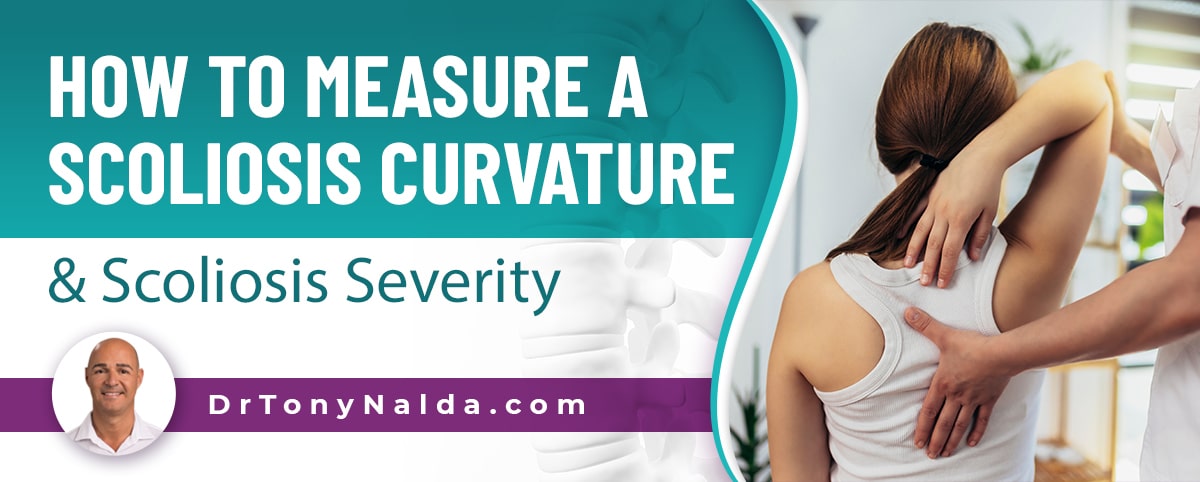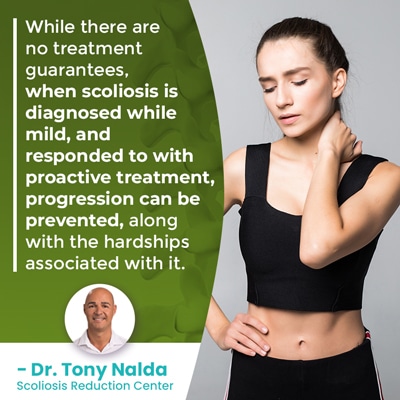How To Measure A Scoliosis Curvature & Scoliosis Severity

When it comes to scoliosis, the most important measurement is a patient’s Cobb angle as it indicates how far out of alignment the unnatural spinal curve has made the spine. In addition, it classifies conditions as mild, moderate, severe, or very severe. Condition severity is a key factor that shapes the design of effective treatment plans.
When scoliosis is first diagnosed, the process involves comprehensively assessing conditions so they can be further classified based on key patient/condition variables, one of which is condition severity; this is determined through a measurement known as Cobb angle.
Assessing scoliosis comprehensively is important because the more we know about a condition, the more treatment plans can be customized.
Table of Contents
How is Scoliosis Diagnosed and Measured?
As there are a number of spinal conditions that involve a loss of its healthy curves, there are certain parameters that have to be met to reach a scoliosis diagnosis.
Scoliosis is the development of an unnatural lateral (side-to-side) spinal curve that also rotates, making it a 3-dimensional condition.
In addition, the unnatural spinal curve has to be of a minimum size, and this is determined by a measurement known as Cobb angle.
 A patient’s Cobb angle is determined during X-ray by drawing lines from the tops and bottoms of the most-tilted vertebrae, at the curve’s apex; the intersecting lines form an angle that’s expressed in degrees.
A patient’s Cobb angle is determined during X-ray by drawing lines from the tops and bottoms of the most-tilted vertebrae, at the curve’s apex; the intersecting lines form an angle that’s expressed in degrees.
The higher the Cobb angle, the more misaligned the spine is, the more severe the condition, and the more likely its symptoms are to be noticeable.
Mild scoliosis: Cobb angle measurement of between 10 and 25 degrees
Moderate scoliosis: Cobb angle measurement of between 25 and 40 degrees
Severe scoliosis: Cobb angle measurement of 40+ degrees
Very-severe scoliosis: Cobb angle measurement of 80+ degrees
So a scoliosis curvature is measured during X-ray, with the Cobb angle classifying conditions on a severity scale.
In addition, what’s known as an Adam’s forward bend test, combined with the use of a Scoliometer, can further determine the angle of trunk rotation (ATR), meaning how much the spine is twisted, in addition to bending unnaturally to the side.
Now, a key condition characteristic to understand is that scoliosis is progressive, meaning its nature is to get worse over time, particularly if left untreated, or not treated proactively.
So where a scoliosis is at the time of diagnosis, in terms of severity, is not indicative of where it will stay.
Scoliosis can easily progress from mild to moderate and severe to very severe; only proactive treatment can work towards counteracting the condition’s progressive nature.
There are also different types of scoliosis, with the most common being adolescent idiopathic scoliosis (AIS), diagnosed between the ages of 10 and 18, which is the form we’ll currently focus on.
Now that we’ve addressed how an unnatural spinal curve is diagnosed as scoliosis and further classified, let’s discuss the severity levels of mild, moderate, and severe for a better understanding of why proactive treatment is so important.
Mild Scoliosis
When it comes to mild scoliosis, this is where treatment can make the most impact, which is why I believe in starting treatment as close to the time of diagnosis as possible.
With mild scoliosis, the most common symptom in adolescents is postural deviation, and this is due to the uneven forces the condition introduces to the spine and body.
The condition’s earliest indicators are often uneven shoulders and hips, and when it comes to adolescent idiopathic scoliosis, pain isn’t generally an issue, which is why early detection isn’t always easy to accomplish.
For children and adolescents, scoliosis isn’t a compressive condition; it doesn’t become compressive until skeletal maturity has been reached, which is why the main symptom of scoliosis in adults is pain, due to compression of the spine and its surrounding muscles and nerves.
So knowing the early signs of mild scoliosis can be beneficial in terms of early detection and treatment success, and along with uneven shoulders and hips, additional postural changes can include:
- Uneven shoulder blades
- The development of a rib arch
- Uneven waistline
- Arms and legs that appear to hang at different lengths
Mild Scoliosis Treatment
As mentioned, with scoliosis treatment started early in a condition’s progressive line (mild, moderate, severe, and very severe), there are fewer limits to what can be achieved.
As scoliosis progresses with growth and development and a scoliotic curve gets larger, this means the condition’s uneven forces are also increasing, and the spine is getting more rigid, making it less responsive to treatment.
When scoliosis is mild, the spine is at its most flexible, the body hasn’t had time to adjust to the unnatural spinal curve’s presence, and its symptoms aren’t always overt.
Here at the Scoliosis Reduction Center, I address mild scoliosis proactively, in an effort to prevent progression, escalating symptoms, and the need for more invasive treatment in the future.
Through a conservative chiropractic-centered treatment approach, I use chiropractic care to work towards reducing the curve on a structural level, and once I see structural results, I can shift the focus to increasing core strength so the spine is optimally supported by its surrounding muscles.
 While there are no treatment guarantees, when scoliosis is diagnosed while mild, and responded to with proactive treatment, progression can be prevented, along with the hardships associated with it.
While there are no treatment guarantees, when scoliosis is diagnosed while mild, and responded to with proactive treatment, progression can be prevented, along with the hardships associated with it.
Moderate Scoliosis
The reality is that most adolescent idiopathic scoliosis patients are diagnosed during the moderate stage of progression because, as mentioned, mild scoliosis symptoms can be subtle and difficult for anyone, other than an expert, to notice.
When a condition progresses from mild to moderate, its symptoms tend to become more overt, and postural changes are more pronounced.
In addition to uneven shoulders, hips, a rib arch, etc, additional symptoms of moderate scoliosis can include:
- Changes to gait
- Balance issues
- Coordination issues
- Proprioception issues
- Ill-fitting clothing
Due to the condition’s uneven forces, which increase alongside progression, noticeable changes can also involve how a patient holds themselves (posture), walks, and how clothing fits.
As scoliosis can make the arms and legs hang at different lengths, clothing suddenly seeming ill-fitting, with necklines pulling to one side, or sleeve and/or pant cuffs seeming uneven, can be a further indicator that scoliosis is present.
Moderate Scoliosis Treatment
Again, here at the Center, being proactive with treatment is the keystone of my conservative chiropractic-centered treatment approach.
I start treatment as close to the time of diagnosis as possible because the earlier in a condition’s progressive line that treatment is started, the more responsive the spine is likely to be.
For my moderate scoliosis patients, I monitor them closely for progression and adjust treatment plans based on how the spine is responding to treatment.
As growth and development is the condition’s main trigger for progression, adolescents are at risk for rapid-phase progression due to the stage of puberty with its rapid and unpredictable growth spurts, so a goal of treatment is to reduce the curve and hold it there, despite the constant trigger of growth.
Through condition-specific chiropractic care, I apply a series of chiropractic techniques and manual adjustments to work towards repositioning the most-tilted vertebrae back into alignment with the rest of the spine.
Through physical therapy and a series of scoliosis-specific exercises (SSEs), I can help patients increase their core strength so the spine is optimally supported, and corrective bracing can be particularly effective on growing spines by pushing the spine into a corrective position.
But what if a condition progresses into the severe classification? Is it still treatable?
Severe Scoliosis
With a Cobb angle measurement of 40+ degrees, this is considered severe scoliosis, and the reality is the more severe a condition is, the more likely it is to continue progressing.
For my severe scoliosis patients, postural changes are overt, including a prominent lean to one side, and as these curves have already progressed significantly, the spine is going to be more rigid, making treatment more complex.
When scoliosis progresses from moderate to severe, the risk of related complications increases, including headaches/migraines, digestive issues, lung impairment, and pain.
Severe Scoliosis Treatment
Regardless of patient age and/or severity, the best time to start scoliosis treatment is always now.
With some of my severe scoliosis patients, particularly my adult patients, as the condition has progressed significantly, the spine’s rigidity becomes an issue.
When a scoliotic spine is excessively rigid, it’s going to be less responsive to treatment, especially chiropractic adjustments that are needed to work towards impacting the condition on a structural level.
In addition, certain types of physical therapy and exercises with corrective potential can’t be performed without first establishing a baseline level of spinal flexibility.
If needed, once work has been done to increase spinal flexibility, treatment for severe scoliosis includes combining multiple condition-specific treatment disciplines: chiropractic care, in-office therapy, corrective bracing, and custom-prescribed home exercises.
When treatment is successful, this means the curve has been reduced on a structural level, meaning the spine is back in alignment, the muscles surrounding the spine are stronger and better able to support it, corrective bracing has helped augment corrective results, and a series of custom-prescribed home exercises help patients establish a home-rehabilitation program to further stabilize the spine for long-term sustainable results.
Conclusion
Measuring a scoliosis curvature isn’t a simple process, which is why a scoliosis specialist is needed.
Through a series of comprehensive measurements that involve the angle of trunk rotation (ATR) and a patient’s Cobb angle, I can see what’s happening in and around the spine.
The complex nature of scoliosis necessitates the customization of effective treatment plans, and condition severity, determined by Cobb angle, is a key patient/condition characteristic that shapes the design of treatment plans.
A scoliosis curve is measured from its most-tilted vertebrae, and this tells me how far out of alignment a scoliotic spine is, and classifies conditions as mild, moderate, severe, or very-severe scoliosis.
Here at the Center, I have experience treating all types and severity levels of scoliosis, so if you, or someone you care about, has been recently diagnosed, don’t hesitate to reach out for guidance and support that can lead to an improved quality of life.
Dr. Tony Nalda
DOCTOR OF CHIROPRACTIC
After receiving an undergraduate degree in psychology and his Doctorate of Chiropractic from Life University, Dr. Nalda settled in Celebration, Florida and proceeded to build one of Central Florida’s most successful chiropractic clinics.
His experience with patients suffering from scoliosis, and the confusion and frustration they faced, led him to seek a specialty in scoliosis care. In 2006 he completed his Intensive Care Certification from CLEAR Institute, a leading scoliosis educational and certification center.
About Dr. Tony Nalda
 Ready to explore scoliosis treatment? Contact Us Now
Ready to explore scoliosis treatment? Contact Us Now





